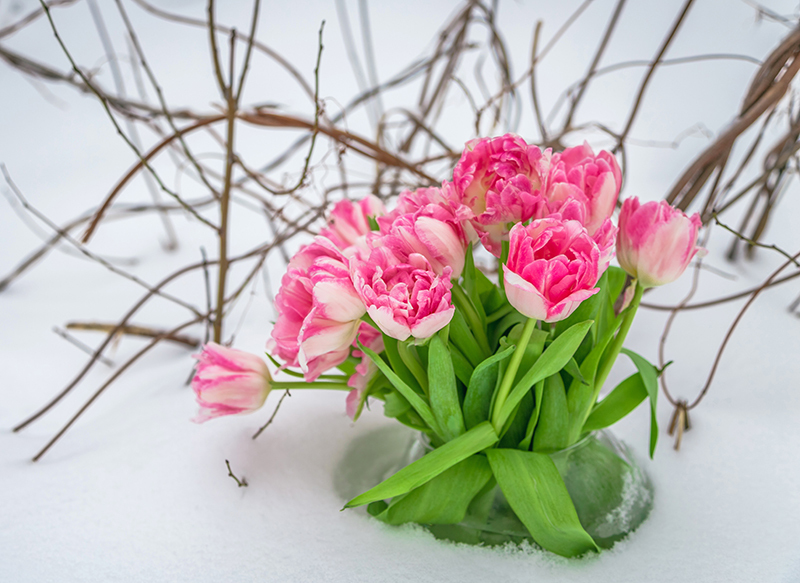Explore the Unseen World: 8 Little-Known Sunflower Facts
Posted on 03/07/2025
Explore the Unseen World: 8 Little-Known Sunflower Facts
Sunflowers - those cheery, tall stalks that light up gardens and landscapes with bold, golden faces - are universally recognized as icons of summer, growth, and positivity. Yet, beyond their sunny appearance and symbolic meaning, sunflowers hide a trove of surprising secrets and fascinating science. Whether you adore sunflower seeds in your snacks or simply admire their beauty, diving deeper into the world of sunflowers reveals intriguing stories, curious facts, and natural wonders. Let's journey together and explore 8 little-known sunflower facts that may change how you see these radiant blooms forever!

1. Sunflowers Aren't Just Yellow
When you think of a sunflower, what image immediately pops to mind? Most people envision a golden disk surrounded by vibrant yellow petals. While traditional sunflowers certainly fit this iconic look, the world of sunflower varieties is much more diverse than you might expect!
- Color Diversity: Sunflowers come in a surprising palette. From deep burgundy and inky mauve to ivory, lemon, and orange tints, horticulturists and gardeners have cultivated a rainbow of sunflower hues. Some popular non-yellow sunflowers include the 'Moulin Rouge' (burgundy), 'Italian White' (cream), and 'Autumn Beauty' (multi-toned).
- Petal Patterns: Beyond color, some sunflowers exhibit double petals, fringed edges, or even pollenless heads, making them perfect for allergy-conscious homes.
Fact in Focus: Scientists continue to develop new varieties with unique shapes and colors, adding to the hidden diversity of sunflowers.
2. Sunflowers Track the Sun, but Only When They're Young
A commonly shared sunflower fact is that these blooms follow the sun across the sky - a process called heliotropism. But what's lesser known is *exactly* when and how this happens.
The Science of Heliotropism
- Young Sunflowers: It's the young, growing sunflower plants that exhibit heliotropism. Their flexible stalks shift east to west throughout the day, maximizing photosynthesis.
- Mature Sunflowers: As sunflowers mature, their stems stiffen and the flower heads usually lock facing east. This eastward orientation protects blooms from overheating and attracts pollinators in the morning.
Did you know? Botanists discovered that "sun-tracking" stops as the internal circadian clock of a sunflower changes with age - a sophisticated feat of plant evolution.
3. A Single Sunflower Is Not Just One Flower
While sunflowers look like a single large flower, each apparent "bloom" is actually a composite flower head made up of thousands of tiny individual flowers called florets.
- Central Disk Florets: These small, tubular flowers fill the middle of the sunflower and mature into seeds.
- Ray Florets: The petal-like structures aren't petals at all, but specialized flowers that help attract pollinators.
Comprehensive sunflower knowledge like this reveals a world of complexity behind that iconic face. In fact, many flowers in the Asteraceae family (daisies, asters) share this intricate design.
4. Sunflower Seeds Are Packed with Nutrition and Versatility
Beyond their beauty, sunflower seeds play a huge role in global cuisine, nutrition, and agriculture. If you only think of them as a snack or bird food, you're missing out!
- Protein Powerhouse: Shelled sunflower kernels are rich in plant protein, healthy fats, vitamin E, magnesium, and selenium - vital for heart health and cell repair.
- Cooking Oil: Sunflower oil, cold-pressed from seeds, is popular worldwide for frying and baking thanks to its light taste and high smoke point.
- Vegan Ingredient: Sunflower seed butter is a popular alternative to nut butters for allergies. Even "sunflower milk" is emerging as a dairy-free drink.
*Sunflowers pack more than just visual appeal - they're a nutritional and culinary treasure waiting to be discovered!*
5. Sunflowers Have Been Cultivated for Thousands of Years
While many associate sunflowers with modern gardens, their history stretches back millennia. Ancient Native Americans first domesticated sunflowers in North America.
- Historic Uses: Archaeological evidence shows sunflower seeds were ground into flour, pressed for oil, or eaten whole as early as 3,000 BC.
- Cultural Symbolism: For many Indigenous tribes, the sunflower represented harvest, bounty, and the Sun's life-giving energy.
- Global Spread: Spanish explorers brought sunflowers to Europe in the 16th century, where they quickly became agricultural and ornamental favorites worldwide.
Tip: Studying the hidden history of sunflower cultivation offers a window into ancient agriculture, trade, and human adaptation.
6. Sunflowers Can Clean Up the Environment
Another surprising sunflower fact: these plants aren't just pretty--they're eco-heroes. Sunflowers possess remarkable phytoremediation abilities, meaning they can absorb environmental toxins.
- Chernobyl & Fukushima: After both nuclear disasters, sunflowers were planted to soak up radioactive contaminants from water and soil.
- Heavy Metals: Sunflowers can extract harmful elements like lead, arsenic, and uranium--making them a green ally for polluted landscapes.
- Renewable Energy: Their rapid growth and high biomass also make sunflowers promising sources for biofuels and green energy.
Takeaway: The unseen power of sunflowers lies in their role as natural cleaners and renewable energy resources.
7. Sunflowers Grow Exceptionally Tall--and Set World Records
Most gardeners know sunflowers grow tall, but just *how* tall can these giants get? The answer might amaze you.
- World Record: The tallest ever recorded sunflower reached an astonishing 9.17 meters (30 feet 1 inch). Grown by Hans-Peter Schiffer in Germany in 2014, this botanical marvel remains unbeaten.
- Giant Varieties: Many hybrid sunflower varieties routinely reach 12-15 feet in one growing season.
- Fast-Growing: From seed to flower, sunflowers can sprout and shoot up in just a few months, making them a favorite for children and time-lapse photography.
*Sunflower enthusiasts often compete to grow "giant sunflowers," with local fairs celebrating towering stalks and record-breaking blooms!*
8. Sunflower Patterns Reflect Mathematical Perfection
Perhaps one of the most fascinating hidden sunflower facts is their connection to mathematics, specifically the Fibonacci sequence and the Golden Ratio.
- Seed Arrangements: Look closely at the spirals in a sunflower's central disk. They form precise patterns that follow the Fibonacci sequence (1, 1, 2, 3, 5, 8, 13, ...), nature's most efficient packing strategy.
- Golden Angle: Each seed is oriented at about 137.5 degrees from the next, optimizing space and sunlight exposure. This is known as the golden angle, seen in pinecones, pineapples, and shells too!
- Research Applications: Scientists use sunflower seed patterns to model everything from genetics to spaceship design.
Fact: The mathematical world of sunflowers bridges botany, art, and science -- a true testament to nature's ingenuity.
Bonus Fact: Sunflowers Support Biodiversity
One final, often overlooked aspect of sunflowers' unseen world is their vital role in supporting wildlife.
- Pollinators: Bees, butterflies, and other beneficial insects flock to sunflowers for pollen and nectar, contributing to healthy ecosystems.
- Birds and Small Mammals: Once seeds mature, they become a feast for goldfinches, sparrows, and squirrels.
Note: Planting sunflowers in your garden adds beauty and offers a crucial food source for local wildlife--even in city settings.

How to Grow Your Own Little-Known Sunflower Varieties
Inspired to bring unique sunflowers into your space? Whether you wish to grow towering giants, curated color blends, or tiny, pollenless blooms, growing sunflowers is rewarding and surprisingly easy.
- Pick Your Variety: Choose from heirloom types or new hybrids to match your space and aesthetic.
- Full Sun: Sunflowers thrive in 6-8 hours of direct sunlight per day.
- Well-Drained Soil: Loose, nutrient-rich soil helps roots spread and stalks strengthen.
- Direct Sowing: Plant seeds outdoors after the last spring frost; avoid transplanting if possible to prevent root disturbance.
- Watering: Keep soil moist, but not soggy, especially during germination and early growth.
- Support: Tall varieties benefit from staking to prevent wind damage.
Tip: Experiment with different sunflower types to create a living tapestry of colors, heights, and textures!
Conclusion: Unlocking the Secret Life of Sunflowers
Sunflowers are more than pretty faces in our gardens or fields. Their unseen world is filled with diversity, scientific intrigue, ancient history, ecological power, and hidden beauty. By learning these little-known sunflower facts, we gain a new appreciation for Helianthus annuus and its dazzling relatives.
Whether you plant sunflowers for their seeds, colors, ecological benefits, or simply for joy, every stalk rises as a marvel of nature. So, next time you see a sunflower, remember: behind that golden smile is a story that spans science, culture, and artistry--just waiting to be discovered.
Will you explore the hidden world of sunflowers in your own backyard this year?
Latest Posts
Efficient Techniques to Ensure Your Flowers Thrive
The Romantic Appeal of Red Roses in Valentine's Celebrations
Essential Care Techniques for Vibrant Cut Flowers





